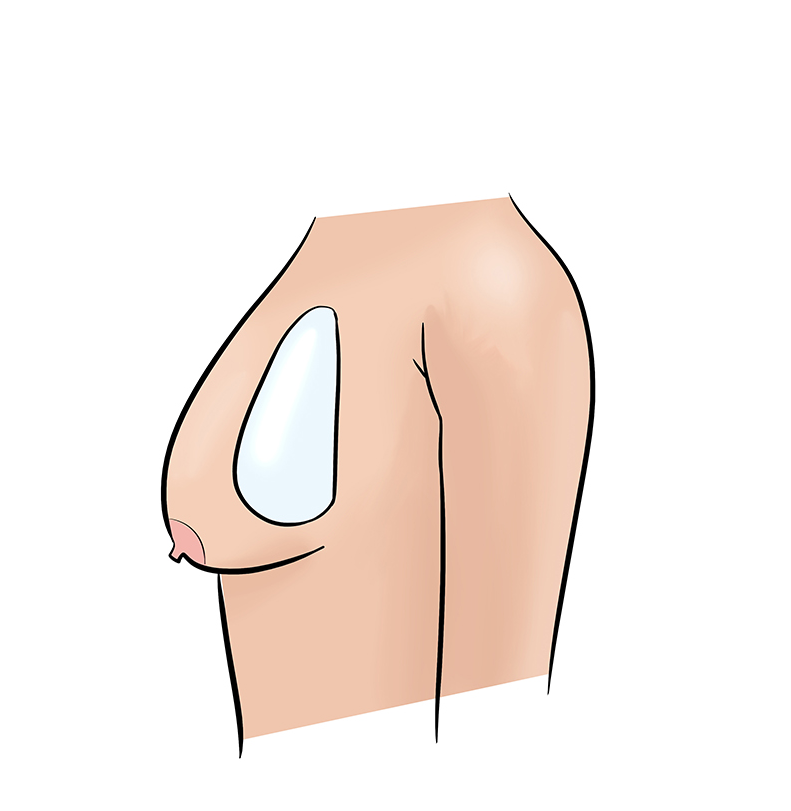Waterfall Deformity after Breast Augmentation
Waterfall Deformity
After the insertion of silicone implants as part of a breast augmentation or breast surgery, it may occur that a waterfall deformity develops.
To learn more about how and why this "waterfall deformity" occurs after breast surgery and what options exist to correct a waterfall deformity, please read the following pages.
Waterfall and Snoopy-Nose Deformity
Viewed in its shape, especially from the profile, this deformation is reminiscent of the shape of a waterfall. This 'waterfall deformity' is also described as the 'Snoopy Nose Deformity' because, when viewed from the profile, it resembles the nose of Snoopy from Charles M. Schulz's comic series 'Peanuts'.
Waterfall or Snoopy-Nose-Deformity

How does a Waterfall Deformity occur?
Most commonly, a Waterfall Deformity arises simply from the lack of coordination between sagging breast tissue and a silicone implant that remains fixed in position, inserted above the chest muscle during breast augmentation or breast surgery
As the skin naturally and age-relatedly sags, the breast and breast gland move downwards, while the implant remains in its "native" position. As the breast gland sags and the nipple lowers, the breast implant becomes visible as a small protrusion in the upper part of the breast, and may also be palpable. The breast gland points downwards over the breast implant, similar to the nose of Snoopy.
When does a Waterfall Deformity occur?
If the Waterfall Deformity only appears long after breast augmentation (several years), it is usually due to a "lack of coordination" between the sagging breast tissue and the implants that remain fixed in their position. The longer the implants are placed under the chest muscle during breast augmentation or breast surgery, the more time the breast tissue has to sag.
However, if the Waterfall Deformity occurs shortly after breast augmentation or six weeks after, the cause may also be due to the wrong choice of implants (shape and/or size) or an incorrect (possibly too high) placement of the implants. It could also be due to a pre-existing deformation of the breast, or the surgeon did not fully cut the lower edge of the muscle to ensure the implant completely fills the under-breast area.
If the surgery does not take into account that the existing breast tissue is already weak and saggy, or that the breast is already drooping, this can contribute to the development of a Waterfall Deformity shortly after breast augmentation.
How can a waterfall deformity be corrected?
Before deciding to correct a Waterfall Deformity through another surgical procedure, you should wait for at least 3 to 6 months. During this time, hematomas that may suggest a diagnosis of Waterfall Deformity after breast augmentation can heal.
Similarly, skin stretching after breast augmentation is possible, which can also cause the implants to sag.
However, if swelling and bruising do not appear to be the cause of the Waterfall Deformity after a fully completed healing process, you should talk to your surgeon about surgical correction.
Adjusting existing breast implants or inserting new implants?
One way to correct a waterfall deformity through a breast revision surgery is to position the already inserted breast implants deeper.
It is also possible and common in practice to replace existing breast implants with new ones that are more suitable in shape and size, such as Motiva implants.
In addition to replacing existing implants or correcting the positioning of already inserted ones, a breast lift can also be performed. This overall tightens the breast tissue.
This lift can correct the waterfall deformity, especially when it occurs several years after the breast implants were inserted, without the need to reposition existing implants.
Waterfall Deformity Treatment in Munich
As an experienced plastic and aesthetic surgeon with proven expertise in the field and a modern practice in Munich, I will be happy to explain to you during an initial personal consultation which treatment method is best to correct an existing waterfall deformity in your specific case.
Excellent specialist in plastic and aesthetic surgery
Over 6000 surgeries - experience from practice and continued education

Things that might also interest you
DR MED CHRISTIAN LENZ IST KNOWN FROM







